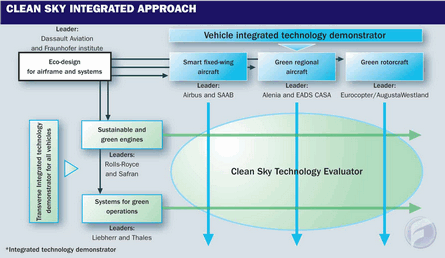The goal of Clean Sky's Sustainable and Green Engines Integrated Technology Demonstrator is to assess, design, build and test up to five full-scale engine demonstrators that will be relevant to a wide range of aircraft, including narrowbody, widebody and regional aircraft, as well as rotorcraft.
The programme will receive €421 million ($640 million) split equally between the European Commission and industry. The programme leaders - Rolls-Royce and Safran - will together require €206 million, half of which will be provided by the EC. Meanwhile, the programme's four principal "associates" - Avio, MTU, ITP and Volvo - will together be allocated €103 million. A further €102 million will be earmarked for additional European participants for which an open call will be issued later this year.
The programme's objectives are closely related to three of the four environmental challenges set by the Advisory Council for Aeronautics Research in Europe: to reduce fuel consumption and CO2 emissions by 50% to reduce perceived external noise by 50% and to reduce NOx by 80%.
Programme participants will identify and select promising technologies - many of which may be part of existing research programmes - and then develop them to a level of maturity so that during the latter half of the seven-year Integrated Technology Demonstrator programme, the resultant prototype hardware can be validated in a realistic operating environment. By the end of the programme, the aim is to deliver mature technologies which can be "dropped into" future engine programmes.
The Demonstrators
Of the possible five engine demonstrators, the initial focus is on open-rotor propfans that programme co-leaders - R-R and Safran - are promoting in their proposals. R-R, for its part, will also continue to advance the efficiency of its proprietary three-shaft turbofan architecture.
"Rolls-Royce is not about to give up on the three-shaft concept, particularly for the larger engines for higher-speed intercontinental aircraft," says Nick Peacock, who is representing R-R. "However, there are other potential architectures that need to be studied [for smaller applications], of which the open rotor is clearly the most high profile at the moment."
He adds: "The open rotor evaluation is going full-steam ahead, and we will not take a decision on launching our second demonstrator - perhaps a three-shaft turbofan - for several more years, and depending on the outcome of the open rotor tests."
Peacock says that the counter-rotating blades of its open rotor proposal will rotate at completely different speeds compared with the two-shaft core. "These blades could either be driven directly by a turbine for each rotor, or by a single turbine linked to the input of an epicyclical gearbox with two counter-rotating outputs - which is our preferred approach."
R-R will consider pusher (with the blades at the back), and tractor configurations (with blades at the front). "Each approach has its own complexities and challenges, which this programme intends to address," he says.
"I don't think anybody is saying that these engines will be as quiet as modern turbofans," he acknowledges. "We can develop the technology, but the market has to decide whether it wishes to go for lowest possible CO2 emissions, or absolutely the lowest noise. It may be that no one technical solution provides both of those objectives."
 |
|---|
Valérie Guénon is Safran's representative in the Clean Sky programme. "Safran's open rotor project will be fundamentally different from Rolls-Royce's configuration," Guénon says. "Snecma will explore an open rotor with a contra-rotating turbine driving the blades directly without a gearbox."
Trade-Off
Guénon acknowledges that there may be trade-off with the noise and public acceptance of the open rotor without a cowl to shield the blade noise. "However, we have made significant progress in terms of noise and CO2. But now we are at the stage when we must take new steps, and with them comes a certain level of risk."
Another contribution from Safran will come from its Turbomeca division, which has submitted a proposal for an environmental helicopter [turboshaft] powerplant. "This will incorporate quite ambitious technologies such as a compressor with variable pressure ratio."
Meanwhile, MTU is leading a team that includes Avio, the DLR research institute and Volvo Aero to develop a geared-fan technology demonstrator. "For Clean Sky, we could use the Pratt & Whitney geared turbofan being defined today, or it might be GTF hardware that emerges from the development programmes of Mitsubishi and Bombardier's CSeries, which will use the initial GTF engine," says Dr Hermann Scheugenpflug, director technology management for MTU Aero Engines. He adds that Avio, MTU and Volvo are partners in P&W's GTF.
"Moreover, with the additional time available [during the seven-year Clean Sky project], we hope to improve upon today's GTF design, specifically to reduce fuel burn by 3-5 %."
Target areas for efficiency improvements or weight savings include the high-pressure compressor and low-pressure turbine. For the turbine mid-frame, Volvo and MTU aim to reduce the length and weight of the interduct between the HPT and LPT. Meanwhile, Avio will develop the fan drive gear system.
Source: Flight International























